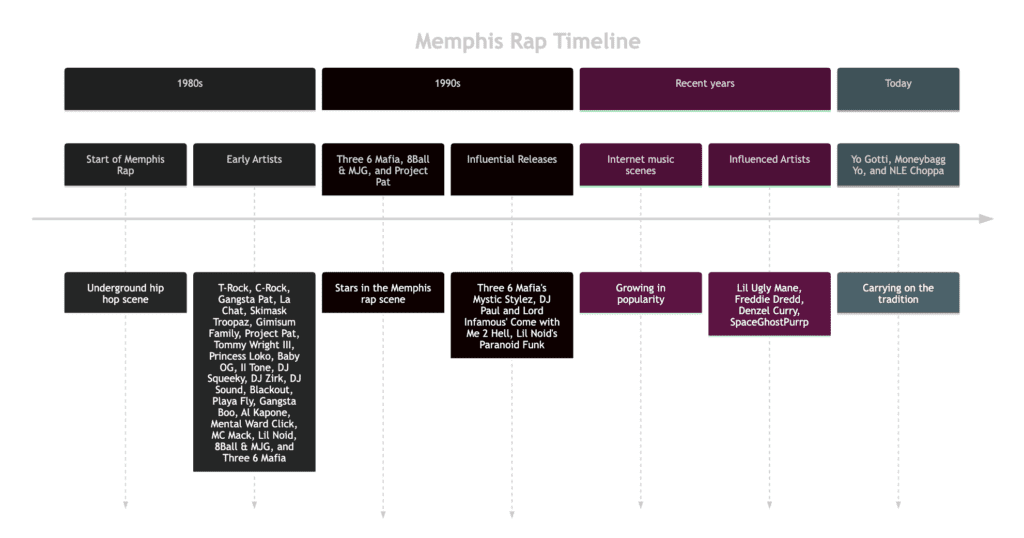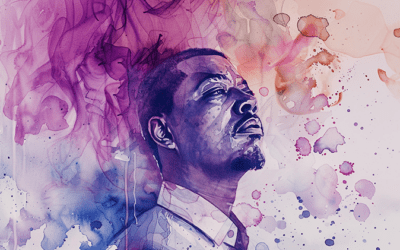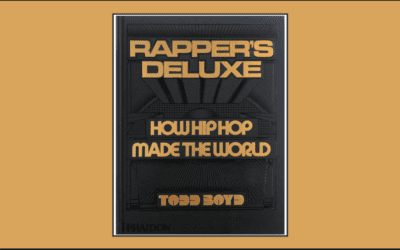The Genesis of Memphis Rap: The 1980s
Memphis, Tennessee, a city steeped in rich musical history, has been a crucible for various music genres, from blues and rock ‘n’ roll to soul and gospel. However, in the 1980s, a new sound emerged from the city’s vibrant streets and neighborhoods – later recognized as Memphis Rap, including crunk, proto-trap, horrorcore, and phonk.
The Birth of a New Sound
The early 1980s saw the advent of hip-hop in the United States, with its roots in New York City. As this new genre began to spread across the country, it found a unique resonance in the city of Memphis. The city’s deep-rooted musical culture and socio-economic realities provided a fertile ground for the birth of a distinctive rap style.
Memphis Rap in the 1980s was characterized by its raw, lo-fi sound, often produced on rudimentary equipment. The lyrics reflected the city’s gritty reality, with themes revolving around poverty, crime, and the struggle for survival. This was a stark departure from mainstream hip-hop’s more polished and commercial sound at the time.
Key Memphis Rap Artists in the 1980s
Several artists emerged during this period, each contributing to the development and evolution of the Memphis Rap sound.
DJ Spanish Fly
One of the pioneers of Memphis Rap, DJ Spanish Fly, began his career in the mid-1980s. Known for his mixtapes, Spanish Fly’s music blended gritty lyrics and heavy bass lines, a style that would become a defining characteristic of Memphis Rap. You can hear many of the same elements in “Cement Shoes” that would later show up in the 90s, including an 808 cowbell melody and a chill sample.
Gangsta Pat
Another key figure in the early Memphis Rap scene was Gangsta Pat, one of the first rappers from the city to achieve national recognition. His debut album, #1 Suspect, released in 1991, was a critical success and helped bring Memphis Rap to a wider audience.
Evolution and Transformation
As the 1980s progressed to the 1990s, Memphis Rap began to evolve. The raw, lo-fi sound of the early years started to give way to a more polished and refined style. This was partly due to advancements in recording technology but also a reflection of the genre’s growing maturity.
Despite these changes, the core elements of Memphis Rap remained. The lyrics continued to reflect the harsh realities of life in the city, and the music retained its distinctive, heavy bass sound.
1980s Memphis Hip-Hop Conclusion
The 1980s were a pivotal period in the history of Memphis Rap. It was a time of genesis and evolution when a new sound emerged from the city’s streets and took its place in the annals of American music. The artists of this era laid the foundation for a genre that would continue to grow and evolve, influencing generations of musicians to come.
Memphis Rap in the 1990s: Evolution and Expansion


The 1990s marked a significant period in the evolution of Memphis Rap, with the genre gaining wider recognition and influence. This decade saw the emergence of new artists and a shift in the musical style while retaining the distinctive characteristics that defined Memphis and later hip-hop across the country.
The Aesthetic of Memphis Rap in the 90s
Memphis Rap in the 90s retained its lo-fi soundscape, characterized by the use of the Roland TR-808 drum machine and minimal synth melodies. The genre continued to feature double-time flows with triplet flows and the use of samples ranging from soul and funk to horror film scores and classical music. The lyrics remained dark, often depicting graphic subject matter, reflecting life’s raw and unfiltered reality in Memphis.
The 90s also saw a split in the Memphis scene between those who preferred the live sound and those who favored the synthetic drum-kit sound introduced by DJ Spanish Fly with the TR-808. The Memphis rap sound was marked by strong drum beats, cowbell, syncopated rhythms, powerful sub-bass, and sharp digital snares. Looping, rather than chopped edits, became a signature of the genre.
Key Artists of the 90s
The 90s saw the rise of several influential artists in the Memphis Rap scene.
Three 6 Mafia: The Most Known Memphis Rap Group
Three 6 Mafia, one of the most successful groups to emerge from Memphis, played a crucial role in bringing Memphis Rap to a wider audience. Their album Mystic Stylez and other releases by members of the group were particularly influential in the genre’s development. Explore the best Triple 6 Albums in our comprehensive guide.
Learn more about Most Known Unknown. Learn more about their classic debut here.
8Ball & MJG: Memphis Rap Legends
8Ball & MJG, another prominent act from Memphis, also achieved considerable success during this period. Their music, while rooted in the Memphis Rap tradition, also incorporated elements of other genres, contributing to the evolution of the Memphis sound.
DJ Sound: The Maestro of Mixtapes
DJ Sound, a prominent figure in the Memphis rap scene, was known for his unique style that combined fast-paced beats with dark, gritty lyrics. His mixtapes were a staple in the Memphis rap scene, and his influence can still be felt today. A key song from DJ Sound is “Vol. 9 – Negative Thoughts”. Listen to the full mixtape below:
Tommy Wright III: The Street Poet
Tommy Wright III, another influential figure, was known for his raw and unfiltered portrayal of street life in Memphis. His music was characterized by its fast-paced beats and aggressive lyrics. His song “Meet Yo Maker” takes 808 cowbell melodies to another level. Listen below:
Project Pat: The Rap Storyteller
Project Pat, a member of the famous group Three 6 Mafia, was known for his storytelling abilities. His lyrics often depicted the harsh realities of life in Memphis. His song “Chickenhead” is a classic example of his storytelling style.
Al Kapone: The Memphis Pioneer
Al Kapone was one of the pioneers of Memphis rap. His music was characterized by its raw energy and powerful lyrics. His song “Lyrical Drive-By” is a classic example of his style.
Blackout: The Beatmaker
Blackout was known for his production skills. He produced beats for many prominent Memphis rappers, contributing to the distinctive sound of Memphis rap. His song “Dim tha Lights” showcases his production skills.
La Chat: The Queen of Memphis Rap
La Chat was among the few female rappers in the Memphis rap scene. She was known for her aggressive style and powerful lyrics. Her song “You Ain’t Mad Iz Ya” is a classic example of her style. Her collaboration with Gangsta Boo is also worth a listen.
Da Crime Click: The Group Effort
Da Crime Click was a group known for its dark, gritty style. Their music often depicted the harsh realities of street life in Memphis. Their song “Million Wayz To Murda” represents their style.
The Frayser Click: The Collective
The Frayser Click was a collective of rappers from the Frayser neighborhood in Memphis. They were known for their raw, unfiltered style. Their song “Gone On That Bay” is a classic example of their style.
DJ Zirk: The Innovator
DJ Zirk was known for his innovative style. He was one of the first Memphis rappers to incorporate elements of electronic music into his beats. His song “Lock Em In Da Trunk” represents his dark, innovative style.
10 Wanted Men: The Memphis Rap Outlaws
10 Wanted Men was a group known for their aggressive style and dark lyrics. Their music often depicted the harsh realities of life in Memphis. Tommy Wright III lead the group. LA Chat was also a member.
Lil Noid: The Enigma
Lil Noid was a rapper known for his dark, gritty style. His music often depicted the harsh realities of life in Memphis.
Evil Pimp: The Horrorcore Icon
Evil Pimp was known for his horrorcore style, characterized by dark themes and violent lyrics. His song “Da Exorcist Returns” is a classic example of his style.
Memphis Rap: Influence and Legacy
Despite largely remaining underground, Memphis Rap of the 90s has impacted the hip-hop genre. It has influenced several artists, including Lil Ugly Mane, Freddie Dredd, Denzel Curry, and SpaceGhostPurrp, and has seen a resurgence in popularity through artists like the Suicideboys. The genre also played a role in the rise of crunk, trap music, and phonk.
In conclusion, the 1990s were a transformative period for Memphis Rap. The genre evolved and expanded, influencing a new generation of artists and leaving a lasting legacy in the world of hip-hop.


